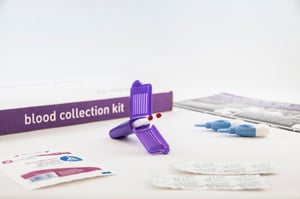Share this
5 reasons why at-home blood sample collection is the new normal
by Neoteryx Microsampling on Aug 10, 2020 9:48:19 AM
 The number of people going to labs for blood draws and blood tests has reduced in the wake of the SARS-CoV-2 pandemic. As a result, more patients are opting for at-home blood sample collection. Many patients are postponing routine tests and medical care to minimize the spread of the coronavirus. Some labs are reporting as much as a 40% decline in phlebotomy appointments and blood test volumes. Quest Diagnostics, for example, reported a notable decline in test volumes in the last two weeks of March 2020.
The number of people going to labs for blood draws and blood tests has reduced in the wake of the SARS-CoV-2 pandemic. As a result, more patients are opting for at-home blood sample collection. Many patients are postponing routine tests and medical care to minimize the spread of the coronavirus. Some labs are reporting as much as a 40% decline in phlebotomy appointments and blood test volumes. Quest Diagnostics, for example, reported a notable decline in test volumes in the last two weeks of March 2020.
These changes have caused health institutions to adopt new practices and technologies that enable patients to perform their own blood collection or self-tests while safe at home. More care providers are using telehealth, a virtual mode of healthcare that supports virtual interactions with patients during the coronavirus pandemic to help reduce disease exposure. A survey of physicians conducted in April 2020 found that up to 85% of participants were seeing patients via phone and video. The survey also showed that 77% of the participating physicians supported the transition to telemedicine.
It is this drive to interact with patients and clinical trial participants while they are safe at home that has increased the demand for remote blood collection and testing. Some labs are going with the remote trend, while others are slow to adopt methods that would enable testing of remote blood samples. However, with the pandemic showing no signs of decline, remote blood collection and testing might be the new normal.
For those still not convinced, these 5 advantages explain why remote blood collection is a popular option:
1. Access
With remote blood collection, patients living far from metro centers don’t have to travel to health facilities for blood draws. Telehealth technologies, such as wireless heart monitors and remote devices, enable physicians to conduct remote patient monitoring and order blood tests that can be conducted on patient-collected samples. What’s more, patients have more – not less – access to their doctors via email and video chat platforms like GoToMeeting, Zoom, and others.
2. Comfort
The Mitra® microsampler uses patented volumetric absorptive microsampling (VAMS®) technology, which involves collecting small, volumetrically accurate blood samples on the absorbent tip of the device. The method improves the patient experience, because it’s easier to use than other self-sampling devices and is less painful and stressful than venipuncture blood draws. Patients can collect precise samples of blood at home, minimizing the number of visits needed for healthcare follow ups, such as therapeutic drug monitoring.
3. Convenience
Even after the pandemic, clinical trials will be an essential part of research. Remote sampling provides a convenient way of collecting samples from trial volunteers that cannot visit the trial center.
The National Institutes of Health (NIH) is currently using the Mitra microsampler and Mitra Blood Collection Kits for COVID-19 clinical trials. Participants call the NIH to request the remote sampling kit, which can be shipped out to them at home. Participants mail their blood samples back to NIH for analysis in the lab. NIH then uses the data for SARS-CoV-2 studies, in particular, to determine the number of undetected cases of COVID-19 among the United States population.
4. Safety
Remote blood collection promotes safety for both patients and healthcare providers. Patients don’t need to visit a clinic for blood collection or testing. Instead, collection kits are mailed to the patient for blood collection. Patients mail their samples in the provided envelope to the lab for testing.
The patient-centric blood collection approach is rapidly replacing traditional blood draws. A small number of healthcare organizations are still sending phlebotomists to patients’ homes to provide mobile lab services, when needed, but this practice carries some safety risks. Companies like Neoteryx are providing simple at-home blood collection kits with the Mitra microsampling device to help reduce the risk of exposure for patients and health workers.
5. Viability
With patients avoiding in-person blood draws and lab tests, many physician's offices, clinics and labs have been forced to transition their staff to part-time hours or lay off employees, reduce salaries, and suspend 410(k)-matching. The coronavirus pandemic is negatively impacting the viability of many healthcare organizations that can't adapt rapidly to telehealth and the technologies that support it.
When clinics, labs and other healthcare organizations can transition to remote blood collection and testing options, they don’t need to take such drastic business measures. Physicians embracing telehealth in today's environment still need labs and personnel that can process remote specimen samples. When shifting to the use of remote sample collection devices like the Mitra microsampler, personnel can get guidance from Neoteryx on methodology and how to set up for an efficient Mitra microsampling process.

Share this
- Microsampling (206)
- Research, Remote Research (119)
- Venipuncture Alternative (105)
- Clinical Trials, Clinical Research (83)
- Mitra® Device (73)
- Therapeutic Drug Monitoring, TDM (51)
- Dried Blood Spot, DBS (39)
- Biomonitoring, Health, Wellness (30)
- Infectious Disease, Vaccines, COVID-19 (24)
- Blood Microsampling, Serology (23)
- Omics, Multi-Omics (21)
- Decentralized Clinical Trial (DCT) (20)
- Specimen Collection (18)
- Toxicology, Doping, Drug/Alcohol Monitoring, PEth (17)
- Skin Microsampling, Microbiopsy (14)
- hemaPEN® Device (13)
- Preclinical Research, Animal Studies (12)
- Pharmaceuticals, Drug Development (9)
- Harpera Device (7)
- Industry News, Microsampling News (5)
- Antibodies, MAbs (3)
- Company Press Release, Product Press Release (3)
- Environmental Toxins, Exposures (1)
- July 2025 (1)
- May 2025 (1)
- April 2025 (2)
- December 2024 (2)
- November 2024 (1)
- October 2024 (3)
- September 2024 (1)
- June 2024 (1)
- May 2024 (1)
- April 2024 (4)
- March 2024 (1)
- February 2024 (2)
- January 2024 (4)
- December 2023 (3)
- November 2023 (3)
- October 2023 (3)
- September 2023 (3)
- July 2023 (3)
- June 2023 (2)
- April 2023 (2)
- March 2023 (2)
- February 2023 (2)
- January 2023 (3)
- December 2022 (2)
- November 2022 (3)
- October 2022 (4)
- September 2022 (3)
- August 2022 (5)
- July 2022 (2)
- June 2022 (2)
- May 2022 (4)
- April 2022 (3)
- March 2022 (3)
- February 2022 (4)
- January 2022 (5)
- December 2021 (3)
- November 2021 (5)
- October 2021 (3)
- September 2021 (3)
- August 2021 (4)
- July 2021 (4)
- June 2021 (4)
- May 2021 (4)
- April 2021 (3)
- March 2021 (5)
- February 2021 (4)
- January 2021 (4)
- December 2020 (3)
- November 2020 (5)
- October 2020 (4)
- September 2020 (3)
- August 2020 (3)
- July 2020 (6)
- June 2020 (4)
- May 2020 (4)
- April 2020 (3)
- March 2020 (6)
- February 2020 (3)
- January 2020 (4)
- December 2019 (5)
- November 2019 (4)
- October 2019 (2)
- September 2019 (4)
- August 2019 (4)
- July 2019 (3)
- June 2019 (7)
- May 2019 (6)
- April 2019 (5)
- March 2019 (6)
- February 2019 (5)
- January 2019 (8)
- December 2018 (3)
- November 2018 (4)
- October 2018 (7)
- September 2018 (6)
- August 2018 (5)
- July 2018 (8)
- June 2018 (6)
- May 2018 (5)
- April 2018 (6)
- March 2018 (4)
- February 2018 (6)
- January 2018 (4)
- December 2017 (2)
- November 2017 (3)
- October 2017 (2)
- September 2017 (4)
- August 2017 (2)
- July 2017 (4)
- June 2017 (5)
- May 2017 (6)
- April 2017 (6)
- March 2017 (5)
- February 2017 (4)
- January 2017 (1)
- July 2016 (3)
- May 2016 (1)
- April 2016 (2)


Comments (9)